#Hillary’s world art 2023
Explore tagged Tumblr posts
Text




Looks like Sick Boyfriend has to burn another gift from Sick Senpai again
@pony-central what do you think
3 notes
·
View notes
Text
















Ralph Lauren A Way of Living
Home, Lifestyle, Inspiration
by Ralph Lauren
Rizzoli, New York 2023, 543 pages, 23,5x30,5cm, ISBN 978-0-8478-7214-5
euro 78,00
email if you want to buy [email protected]
A stunning celebration of Ralph Lauren’s signature home collections—including the designer’s own homes—which have inspired the world of interior design for nearly half a century. The cinematic vision of Ralph Lauren is brought to life with a stunning and intimately written book that spans decades of innovation and influence by the iconic American designer. Ralph Lauren: A Way of Living, published by Rizzoli New York, commemorates the 40th anniversary of the home collection with the first comprehensive volume dedicated to the signature style of Ralph Lauren and his pioneering lifestyle approach to design. From trailblazing innovations that revolutionized the home industry to conceptualizing residential retailing and perfecting the art of hospitality, Lauren has created a multifaceted world that evokes emotion and inspires a more beautiful way of life. This special volume presents a visual timeline of Ralph Lauren’s remarkable history as a lifestyle innovator. Lauren’s unparalleled ability to seamlessly blend fashion and the home is illustrated with the groundbreaking designs and innovative use of materials that have distinguished the home collection since its inception in 1983: menswear-inspired Oxford Cloth bedding that required the creation of special looms and took two years to refine; the sleek RL-CF1 chair, crafted of carbon fiber and inspired by Lauren’s McLaren F1 racecar; and an appreciation for a timeworn, weathered aesthetic, as exemplified in the iconic Writer’s Chair with its hand-burnished leather and rich patina. Historic achievements such as the opening of his first New York City flagship on Madison Avenue – which invited guests to experience the complete World of Ralph Lauren in a residential environment – and his renowned restaurants that offer the epitome of gracious hospitality, demonstrate the magnitude of Ralph Lauren’s influence on the worlds of lifestyle design and hospitality. The timeline is complete with quotes from distinguished members of the design world and prominent figures of our culture including Oprah Winfrey, Hillary Rodham Clinton, and architecture critic Paul Goldberger. Ralph Lauren’s signature ability to create transportive environments begins with his private homes that inspire his iconic lifestyle collections. Ralph Lauren: A Way of Living offers an in-depth look at all the places Lauren calls home, from a sprawling ranch in Colorado and an island retreat in Jamaica, to a Fifth Avenue penthouse overlooking Manhattan’s Central Park, a seaside home in Montauk and a country estate in Bedford. Lauren’s homes are deeply personal expressions of his vision for living; captivating imagery is complemented by essays and descriptions written in his own words that intimately express the meaning of home and share inspiration and anecdotes for each residence. The photos of Lauren’s captivating homes are followed by a celebration of Ralph Lauren Home’s lifestyle collections – cinematic worlds that are brought to life with iconic imagery showcasing Lauren’s pioneering lifestyle approach and all-encompassing home collection. Ralph Lauren: A Way of Living honors the life and work of a true visionary and innovator. Ralph Lauren’s monumental impact on the way we live is as recognizable today as it was groundbreaking 40 years ago. His vision is not about trends of the moment, but is built upon values and things that last, and his legacy will continue to shape the places we call home.
29/10/24
#Ralph Lauren#way of living#designer's homes#home collection#Colorado#Jamaica#Montauk#Bedford#Manhattan#lifestyle collection#designbooksmilano#fashionbooksmilano
15 notes
·
View notes
Text
2024 Garden Parties!!!
The dates for The King's Garden Parties* in 2024 are as follows:
✨ Buckingham Palace - Wednesday 8th May 2024

The King and Queen, the Duke and Duchess of Edinburgh and the Duke and Duchess of Gloucester hosted the first garden party of 2023
✨ Buckingham Palace - Tuesday 21st May 2024
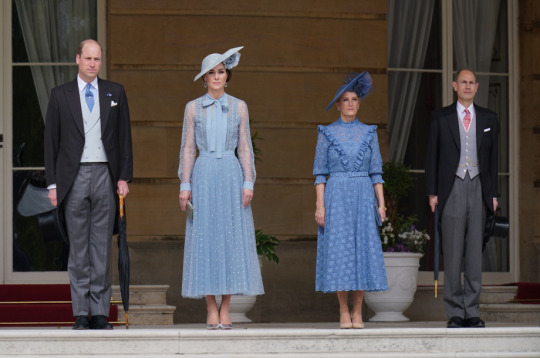
Last year (2023) the Prince and Princess of Wales with the Duke and Duchess of Edinburgh hosted the Kings Garden Party at Buckingham Palace
✨ Palace of Holyroodhouse - Tuesday 2nd July 2024
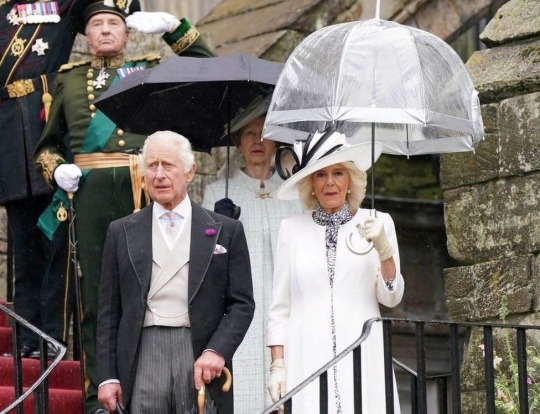
The King and Queen with the Princess Royal hosted last years Holyrood week garden party
*Please note, Garden Parties are traditionally referred to as The Sovereign's Garden Party. Attendance at each Garden Party will be confirmed on the day.
✨ The Creative Industries Garden Party - Wednesday 15th May 2024
His Majesty The King has given permission for a Garden Party to be hosted at Buckingham Palace, with support from the Department for Culture, Media and Sport, in celebration of the Creative Industries of the United Kingdom. The Garden Party will bring together approximately 4,000 representatives across culture, art, heritage, film, TV, radio and fashion.
The Garden Party will celebrate the economic value of the sector to the UK economy in helping to showcase British culture and creativity around the Globe. In 2022 the Creative Industries generated over £124 billion in economic value and employed 2.4 million people in the United Kingdom. From theatre to video games, publishing to design, museums and galleries to film sets and music studios, the creative industries, and the creators and organisations within them, bring happiness, prosperity and help shape the world around us.
✨ The Not Forgotten Association Annual Garden Party - Friday 17 May 2024
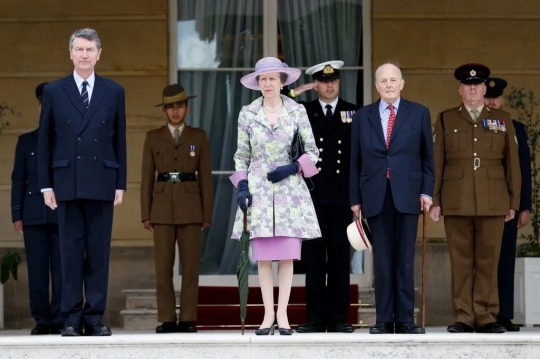
From the Not Forgotten Association garden party in 2022
His Majesty The King has given permission for The Not Forgotten Association Annual Garden Party to be held by The Princess Royal, accompanied by Vice Admiral Sir Tim Laurence, in the Buckingham Palace Garden on Friday, 17th May 2024.
The Not Forgotten Association is a tri-service charity which provides entertainment, leisure and recreation for ex-service men and women with disabilities or illness and serving personnel who are wounded, injured or sick. The Garden Party will bring together 2,000 beneficiaries of all ages and from all services.
The Princess Royal is Patron of The Not Forgotten Association.
✨ Royal National Lifeboat Institution (RNLI) - Thursday 23rd May 2024
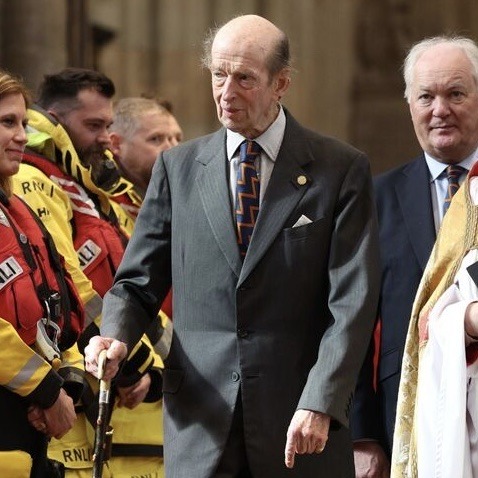

The Duke of Kent and Sir Tim Laurence attending the RNLI 200 service of thanksgiving at Westminster Abbey in March 2024
His Majesty The King has also given permission for the RNLI 200 Anniversary Garden Party to be held by The Princess Royal, accompanied by Vice Admiral Sir Tim Laurence, and The Duke of Kent in the Buckingham Palace Garden on Thursday, 23rd May 2024 in celebration of the charity's milestone anniversary.
Since the RNLI was founded on 4th March 1824, following an appeal to the nation from Sir William Hillary, the charity has saved 146,277 lives - this equates to an average of two lives saved every day for 200 years. Today, the RNLI operates 238 lifeboat stations around the UK and Ireland, including four on the River Thames, and has seasonal lifeguards on around 240 beaches around the UK.
The Duke of Kent has been President of the RNLI since 25th March 1969. In his 55 years as President, the RNLI's volunteer lifeboat crews and beach lifeguards have saved more than 51,000 lives. Sir Tim Laurence is also Vice President of the charity.
The Garden Party will bring together 2,500 of the charity's long-serving volunteers, staff and their families as well as featuring an Atlantic 85 inshore lifeboat.
#exciting!!!#garden parties mean SUMMER!!!!!#these will be so much fun to follow#princess anne#princess royal#tim laurence#timothy laurence#king charles iii#prince edward duke of kent
19 notes
·
View notes
Photo

Cover Art | The Destroyer of Worlds: A Return to Lovecraft Country by Matt Ruff
In this thrilling adventure, a blend of enthralling historical fiction and fantastical horror, Matt Ruff returns to the world of Lovecraft Country and explores the meaning of death, the hold of the past on the present, and the power of hope in the face of uncertainty. Summer, 1957. Atticus Turner and his father, Montrose, travel to North Carolina, where they plan to mark the centennial of their ancestor’s escape from slavery by retracing the route he took into the Great Dismal Swamp. But an encounter with an old nemesis turns their historical reenactment into a real life-and-death pursuit. Back in Chicago, George Berry fights for his own life. Diagnosed with cancer, he strikes a devil’s bargain with the ghost of Hiram Winthrop, who promises a miracle cure—but to receive it, George will first have to bring Winthrop back from the dead. Meanwhile, fifteen-year-old Horace Berry, reeling from the killing of a close friend, joins his mother, Hippolyta, and her friend Letitia Dandridge on a research trip to Nevada for The Safe Negro Travel Guide. But Hippolyta has a secret—and far more dangerous—agenda that will take her and Horace to the far end of the universe and bring a new threat home to Letitia’s doorstep. Hippolyta isn’t the only one keeping secrets. Letitia’s sister, Ruby, has been leading a double life as her white alter ego, Hillary Hyde. Now, the supply of magic potion she needs to transform herself is nearly gone, and a surprise visitor throws her already tenuous situation into complete chaos. Yet these troubles are soon eclipsed by the return of Caleb Braithwhite. Stripped of his magic and banished from Chicago at the end of Lovecraft Country, he’s found a way back into power and is ready to pick up where he left off. But first he has a score to settle. . . . Artwork by Jarrod Taylor
Release date | Feb 21, 2023 Goodreads
#the destroyer of worlds: a return to lovecraft country#the destroyer of worlds#lovecraft country#matt ruff#jarrod taylor#book cover art#book cover reveal#h.p. lovecraft#science-fiction#booklr#bookblr
71 notes
·
View notes
Text
Ylthin's Media Thread thingy for the tail-end of 2023 and 2024:
Normally I'd do it on Twitter but I fully expect that site to collapse in 6 months.
Glen Cook, "Czarna Kompania"/"Cień w ukryciu" ("Black Company"/"Shadows Linger") (Rebis, 2009 Polish edition, 2022 reprint)
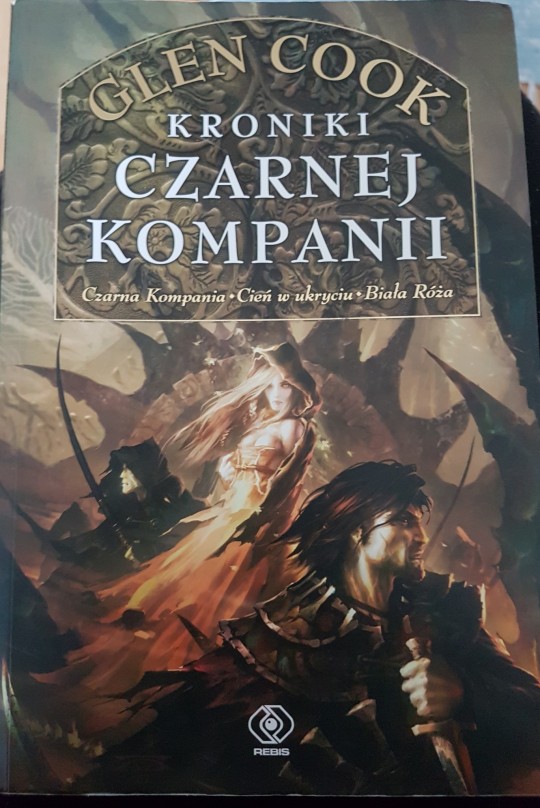
I'm starting this list somewhat off the curb - I've finished the 2nd novel from this omnibus release just now, but I've also read the first one earlier this year... and I don't have much to say about either, honestly.
The prose is kind of clunky and awkward in a way that takes a moment to adjust to, and without directly comparing the Polish translation to the English original I can't tell how much of this unwieldiness is due to poor translation job and how much of it is just inherent to Cook's style. You're not reading this book for its characters, either - most of them are memorable only because of constant exposure, as names that you eventually learn to map to a broad role in the story or one, maybe two vague personality/appearance traits. What carried me through was what I can broadly describe as "vibes" and long-term significance of Black Company books - or maybe the wave of genre-fiction they were a part of. It certainly wasn't the first grim and gritty fantasy series out there, and the backside blurb's boasts about how Cook "brought the fantasy genre down to the level of common men" are very overblown (the books are literally about an evil sorceress' plan for world domination clashing against her messy divorce with her Dark Lord husband and a prophecy about the "divine savior" figure coming back to further piss into her breakfast), but I can still notice the seeds of interesting ideas being planted here and there, and the grit (while going for a very predictable "everyone is utterly miserable and the whores will give you all the STDs" route, and feeling more like catnip for 14-year-old boys rather than genuine "maturity") fortunately doesn't cross the line into unbearable edgelord territories yet. It was a part of the same wave of dark fantasy that either molded me directly (through Sapkowski's The Witcher novels and "Berserk"), indirectly (through a thousand imitators years down the line, from local fantasy authors of the 2000s to video games - Heroes of Might & Magic 5 in particular was retrospectively very blatantly inspired by Warhammer Fantasy), or infected me with sudden-onset brainrot in my mid-20s (Warhammer 40.000), and I can definitely feel and appreciate it even if I find these books to be rather mediocre so far.
I just wish I could get my hands on Moorcock's Elric books without going through a dozen hoops, but I guess I'll make do with Cook, Erikson and the odd Warhammer novel for the time being.
Oh, and this cover art? That tattered "dashing rogue" look, that borderline fractal leather-and-cloth patterning, the random spiky structures in the background? The long bob hair and goatee look straight out of the music video for "Imperium" by Machine Head? A cover that makes you think not even of actual early 2000s buttrock, but of Stuart Chatwood emulating it for Prince of Persia: Warrior Within's soundtrack? Hillariously mismatched with the actual novels. I haven't seen a choice this baffling since reading my dad's faded mid-90s pulp booklet edition of Ursula LeGuin's "Rocannon's World" paired up with either Vallejo or Frazetta sword-and-sandals artwork.
6 notes
·
View notes
Text
The Comic-Book Aesthetic Comes of Age in “Across the Spider-Verse”
The Spider-Man sequel might be the first superhero film to take full advantage of what comic-book art can achieve onscreen.
— By Stephanie Burt | June 14, 2023
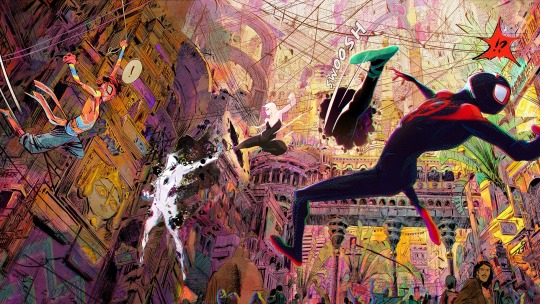
Each of the Spiders in “Spider-Man: Across the Spider-Verse” brings not just an art style but a personality and a backstory.Art work by Aymeric Kevin / Courtesy Sony Pictures
The latest comic-book movie associated with the Marvel Cinematic Universe, “Spider-Man: Across the Spider-Verse,” certainly knows what kind of film it is. Most of the movie follows Miles Morales and Gwen Stacy, two animated teen-aged Spider-People, but, for the sake of the fandom, live actors from live-action blockbusters make surprise cameos. Gwen quips at one point that Doctor Strange—last seen in the M.C.U.’s “Doctor Strange in the Multiverse of Madness”—should not practice medicine. Miles’s high-school roommate references another audience favorite, “Spider-Man: Homecoming” (2017), when he tells Miles, “I’m not your guy in the chair.” Inevitably, there is a meme-inspired scene of Spider-Man pointing at Spider-Man. This is the kind of self-aware fan fodder that, in lesser films, might feel tired.
And yet “Across the Spider-Verse,” which came out on June 2nd, does something that no live-action superhero movie has done before—or can do. It leans hard into, and emulates onscreen, the storytelling devices and the visual flair that make comic books special. Even more than its predecessor, “Into the Spider-Verse” (2018), the film feels designed to show young people, many of whom were raised on superhero movies, why they might care about the comics that launched these characters. It does this so well that, at a time when some Marvel movies haven’t been doing so hot at the box office, “Across the Spider-Verse” has already raked in nearly four hundred million dollars. At 7 p.m. on a Wednesday night, with local schools still in session, my seventh grader and I found most of the seats in our suburban multiplex full.
The first scene in the movie reintroduces us to Miles’s long-distance best friend, Gwen Stacy of Earth-65, a.k.a. Spider-Gwen (voiced by Hailee Steinfeld). Her world looks painterly, as if rendered by brushes and pastels; she often appears in Expressionist shades of blue and pink. That’s how the rest of the film will roll: each Spider-Man, Spider-Woman, or Spider-Villain, and each new Earth on which they live, has its own eye-popping art style. Miles (voiced by Shameik Moore), a Black Puerto Rican physics star who draws in all his notebooks, inhabits a world that evokes hip-hop album covers and graffiti. Miguel O’Hara, or Spider-Man 2099, comes with clean lines, techno details, and RoboCop vibes. Spider-Byte appears as a glowing avatar like the nineteen-eighties film “Tron.” Pavitr Prabhakar, a.k.a. Spider-Man India, swings through his home city of Mumbattan, all tropical colors and curvy architecture. (When characters move between dimensions, they pass through a portal made of hexagons—a basic geometric unit of Hollywood animation.)
Almost all of these characters existed in comic books before they hit the screen, and, crucially, all of them have what the scholar Hillary Chute identifies as the core property of comics: they look like somebody chose to draw them. They bear the mark of their creators’ hands. The Spot, a villain who sets the movie’s main plot in motion, looks like a blank page splattered with ink; each of his splotches opens up a little wormhole, in the same way that the pen stroke of a comic can open up another world. The animators of the film owe a lot to Marvel’s comic artists: the credits thank a “Black Panther” illustrator, Brian Stelfreeze; a co-creator of Miguel O’Hara, Rick Leonardi; and the nineteen-eighties titan Bill Sienkiewicz. All three have contributed to the making of “Across the Spider-Verse.”
The film’s version of Miguel O’Hara (voiced by Oscar Isaac) behaves like a stern, bad Spider-Dad. He resolves to stop Miles from disrupting something called a Canon Event—a plot development so important that it has to happen in every parallel world, lest the entire universe be at risk. “You break enough canons,” Miguel warns, “and we could lose everything.” He sounds almost like a Marvel Comics editor, telling writers that they can’t go too far. (One writer, Grant Morrison, called their longest project at Marvel “more like a prison than a playground.”) In the tradition of print comics, the film offers explanatory notes in 2-D colored boxes; some of them, in an homage to the comics of the nineteen-seventies, are even signed “--Ed.,” for editor.
Like all the best teen superhero comics, “Across the Spider-Verse” hints, or more than hints, at real-life dual identities. The colors that tend to accompany Gwen, blue and pink, are the colors of the transgender flag. A poster in her bedroom says “protect trans kids,” and her father, a police officer who initially has no idea that she is Spider-Gwen, sports a trans-flag pin on his uniform. Gwen tells Miles that her parents “only know half of who I am.” She also wears her hair in an asymmetrical undercut—which, my seventh grader told me, is often a sign of trans or nonbinary identity among Gen Z. (It should not be confused with a half-and-half, my seventh grader added.)
Miles and Gwen both have well-intentioned cops for dads, who try hard but can’t seem to stop enforcing rules. In one scene, Miles tells his father, “Men of your generation ignore their mental health too long.” In part for this reason, Miles and Gwen feel the kind of solidarity that young people can share only with one another. When they finally get some tender alone time above a twilit Brooklyn, Gwen asks Miles, “How many people can you talk to about this stuff?” He tells her, “You don’t even know.” That’s what happens when trans people meet one another, too—something that the Internet pointed out right away. (This isn’t the sole Spider-Man film to be interpreted as an L.G.B.T.Q.+ allegory; some viewers saw Tom Holland’s Spidey as transmasculine, too.)
“Across the Spider-Verse” is a sequel, but it’s arguably the first superhero film to take such full advantage of what comic-book art can achieve. At the Guggenheim Museum, Gwen has to fight a version of an old Spidey villain, the Vulture, who looks, in her words, like a “big flying turkey from the Renaissance.” He’s drawn in the style of ink on parchment, with the scratchy, busy lines you’d expect from a goose-quill pen. He’s not just from another Earth but from a different artistic universe. Elsewhere, several Spider-People chase Miles across the body of a rocket and up what appears to be a space elevator. Theoretically, C.G.I. could help live actors imitate some of these stunts—but not in such colors, and not with such dynamism and glee. In another sequence, Miles races a moving subway train while he fights a pangolin-esque villain, who rolls up in an armored ball. In a live-action film, the scene would cost a ton and still look cheesy. With animation this artful, it’s all part of the fun.
Comics are at their core a visual medium. “Everyone’s first response to your work will be to the visual aspect,” Brian Michael Bendis, the co-creator of Miles Morales, wrote, in his 2014 book about creating comics, “Words for Pictures.” In a comic, the script has to serve the art, which in turn has to serve the characters. And this script does. Each of the Spiders brings not just an art style but a personality and a backstory: tragedy for Miguel, teen heartbreak for Gwen, dad jokes for Peter B. Parker, that lovable sad sack from “Into the Spider-Verse.” (There’s even a Spider-Baby.) Each character and each gadget—one is called a Go-Home Machine—says something about generational change. Today’s kids may feel that they can’t live up to adult expectations and still be themselves. Where, if anywhere, can they find heroes?
Maybe Gen Z could find them in superhero comics, but it’s not clear that they’re reading many. The best-selling U.S. single-issue comic book of all time remains “X-Men No. 1,” published in 1991, which moved more than eight million units; in the past ten years, the best-selling superhero comics have tallied half a million instead. “The captive audiences of the pandemic era are out doing other things,” the comics journalist Heidi MacDonald wrote this year. When Zoomers read comics, it’s often via online platforms such as Tapas and Webtoon, which span genres from high fantasy to romance, or else in all-ages, slice-of-life graphic novels. (“Guts,” by Raina Telgemeier, was America’s most-purchased book—not comic book, book—one week in September, 2019.) “Across the Spider-Verse” could help to boost printed comics. Marvel has leaned hard on movies to promote Spider- titles, including the made-for-mobile online comic “Spider-Verse Unlimited.” Viewers who want to read stories that look like the Spider-Verse might also check out recent issues of “New Mutants,” by Vita Ayala and Rod Reis, in which feelings are more important than fisticuffs, and the expressive art fits the strong emotions.
“Across the Spider-Verse” is full of astonishing action, but a quiet scene midway through, when Miles and Gwen finally get a moment together above Brooklyn, might be the most affecting in the film. It lets viewers—including my rapt seventh grader—contemplate what young people want from one another, what they can never get from adults. Perhaps it’s a budding romance. Perhaps it’s trans bonding. These moments set up the conflict that comes later, when Miguel O’Hara tells Miles what he must do for the multiverse, and Miles, facing a superhero-level trolley problem, just says no. And the whole thing takes place, beautifully, with Brooklyn inverted: Miles and Gwen, using their tenderness, and also their powers, conduct the whole conversation upside down. ♦
7 notes
·
View notes
Text
Hillary Clinton

This Biography is about one of the best Professional Politician of the world Hillary Clinton including her Height, weight, Age & Other Detail… Express info Real Name Hillary Diane Rodham Clinton Nickname Hillary, Hill, HRod, Mrs. Clinton Profession Politician Age (as in 2023) 75 Years old Physical Stats & More Info Party Democratic Party Political Journey • In January 1979, Hillary Clinton became First Lady of Arkansas and retained the title for twelve years (1979-1981, 1983-1992). • She became the First Lady of the United States in January 1993. • In the year 2000, she was chosen by the Democratic Party to run in the Senate Election. • She won the Senate Election with 55% of vote on November 7, 2000. • On January 3, 2001, Hillary Clinton was sworn in as US Senator. • She gave her service on five senate committees - Committee on Budget (2001–2002), Committee on Armed Services (2003–2009), Committee on Environment and Public Works (2001–2009), Committee on Health, Education, Labor and Pensions (2001–2009) and Special Committee on Aging. • In November 2004, she announced to run for a second senate term. • She won the senate election for the second time with 67% of the vote on November 7, 2006. • On January 20, 2007, Hillary Clinton announced her candidacy for the United States Presidential Election of 2008. • She lost South Carolina primary to Obama by two-to-one. • She supported Obama at the 2008 Democratic National Convention by giving a passionate speech. • On December 1, 2008, Obama announced Hillary Clinton as his nominee for Secretary of State. • She took the oath of office of Secretary of State of USA on January 21, 2009. • She has announced her candidacy for the United States Presidential Election of 2016 and at present she is campaigning for the same. • On 8 November 2016, she was defeated by the Republican Donald Trump in the 2016 United States Presidential Election. Biggest Rival Donald Trump Physical Stats & More Of Hillary Clinton Height in centimeters- 167 cm in meters- 1.67 m in Feet Inches- 5’ 6” Weight in Kilograms- 60 kg in Pounds- 132 lbs Eye Colour Blue Hair Colour Blonde Personal Life Of Hillary Clinton Date of Birth October 26, 1947 Birth Place Edgewater Hospital in Chicago, Illinois Zodiac sign/Sun sign Scorpio Nationality American Hometown Chicago, Illinois, USA School Park Ridge, Maine East High School (1964), Maine South High School (1964–1965) College Wellesley College (1965–1969), Yale Law School (1969–1973) Educational Qualifications Bachelor of arts with Departrmental honors in Political Science Debut 1996 Family Father- Hugh Ellsworth Rodham (American businessman) Mother- Dorothy Howell Rodham (American Homemaker) Brothers- Tony Rodham (Consultant), Hugh Rodham (Lawyer) Sisters- N/A Religion Methodist Address 55 West 125th Street New York, USA Hobbies Swimming, Home decor, gardening, playing scrabble, doing crossword puzzles Controversies • Her email controversy is at the top on the list of Hillary Clinton's controversy where she has been criticized for using her personal account to send classified documents during her tenure as United States Secretary of States. • In 1978, Hillary and Bill Clinton were criticized for buying acres of riverfront land to form Whitewater Development Corp. through wrong means. • Clinton Foundation has been criticized for the errors in its tax returns. • She has been criticized in Benghazi case for failing to protect US interests abroad. • She has been criticized for delivering a speech on inequality by wearing a Giorgio Armani jacket worth 12000 USD. Favourite Things Of Hillary Clinton Favorite Politician Martin Luther King Jr. Favorite Quote "Human rights are women's rights. Women's rights are human rights". Favorite Food Hot sauces, DeFrazio’s Pizzeria in Troy, apple, burgers, ice creams, wine Favorite Film Casablanca, The Wizard of Oz, Out of Africa Favorite Book Fyodor Dostoyevsky's 'The Brothers Karamazov', The Return of the Prodigal Son Boys, Affairs and More Of Hillary Clinton Marital Status Married Affairs/Boyfriends Not Known Husband Bill Clinton (married 1975) Children Daughter- Chelsea Clinton (born February 27, 1980) Earning Money Of Hillary Clinton Net Worth 22 million USD This Biography written by www.welidot.com Read the full article
1 note
·
View note
Text
Transformers (UK, vol. 1) #2: The Transformers
Read Date: April 10, 2023 Cover Date: October 1984 ● Writer: Bill Mantlo ◦ Ralph Macchio ● Penciler: Frank Springer ● Inker: Kim DeMulder ● Colorist: Nelson Yomtov ● Letterer: Michael Higgins ◦ Rick Parker ● Editor: Bob Budiansky ●
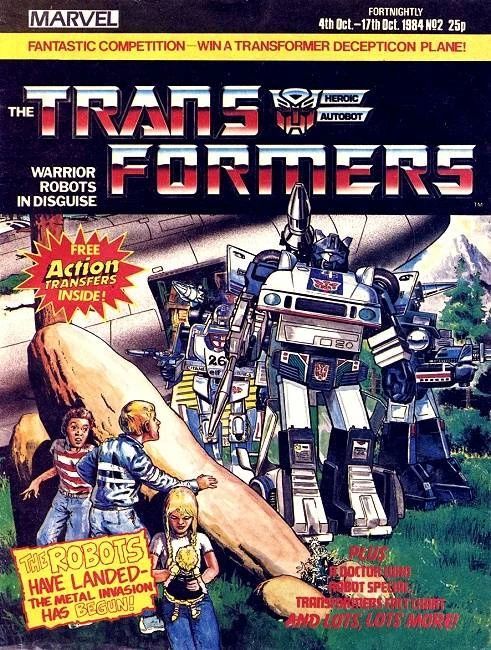
**HERE BE SPOILERS: Skip ahead to the fan art/podcast to avoid spoilers
Reactions As I Read: ● I remember these clunky-but-functional introductions from the US version ● they find a drive-in
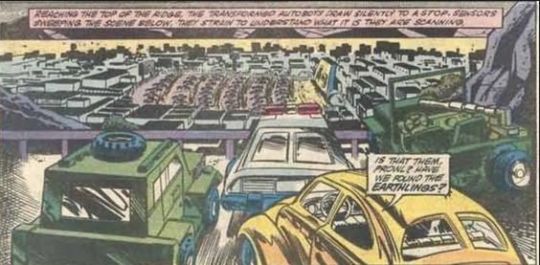
● same stuff happening as in the US version. my memory is bad anyway, so the refresher is good ^_^ ● 👏👏👏👏
Synopsis: The planet Cybertron, home of sentient robots known as the Transformers, has been at war for millions of years, putting the peace faring Autobots at war against the evil war hungry Decepticons, led by the evil Megatron. The devastation wrought by the war would send planet Cybertron out of it's orbit spinning throughout the cosmos on an indirect course, and into the path of an asteroid belt that threatens to destroy their home world unless something is done. Autobot commander Optimus Prime is selected by the Autobot elders to lead a team to destroy the meteors before it's too late.
Optimus Prime selects a crew that consists of the following Autobots: Bumblebee, Cliffjumper, Brawn, Huffer, Gears, Jazz, Prowl, Ironhide, Ratchet, Sideswipe, Sunstreaker, Trailbreaker, Wheeljack, Mirage, and Hound to journey out in their ship, the Ark, to destroy the meteors. Learning of this, Megatron gathers a team of his own Decepticon warriors to attack and destroy the Autobots. With him, he takes Soundwave, Starscream, Thundercracker, Skywarp, Laserbeak, Buzzsaw, Rumble, Frenzy and Ravage to attack.
With the battle leaning toward Decepticon victory Optimus Prime, forseeing this possibility sets the Ark on a suicidal collision course with the nearest planet, which happens to be Earth. They crash into an active volcano, destroying them all. Some four billion years later at the site of the crash at what is now called Mount St. Hillary in Oregon the Ark's computers spring to life sending out a probe to scan what it thinks are the planet's sentient machinery. The ships repair systems repair all the Transformers aboard indiscriminately, repairing the Decepticons first and giving them the ability to transform into Earth machines. They manage to escape before the newly revived Autobots can stop them.
Scanning their computers to learn about the world they have crashed on, Optimus Prime decides to that the best course of action is to send out some Autobots to do reconnaissance before they do whatever needs to be done to protect this world from the Decepticons they unwittingly unleashed on this world.
Elsewhere in the state of Oregon, Buster Witwicky, the son of mechanic Sparkplug Witwicky arrives home late from school and gets in trouble with his father who is frustrated with his son for not having an interest in mechanics like he does. With the days work in his garage just about done he allows his son Buster to take the family car out to take his friend "O" and his girlfriend Jessie out to the theater.
Meanwhile, the Autobots Bumblebee, Cliffjumper, Brawn, Prowl, and Hound are on the road getting a lay of the land in their area. They happen upon a drive-in movie theater and thinking that the cars parked there are sentient beings find it odd that they are focused on a large screen. On their journey, they are spied on by Laserbeak who reports back to Megatron. The Decepticon leader decides to send a Decepticon attack force to ambush the revived Autobots.
The Autobots arrive at the theater, and Bumblebee in an attempt to "greet" an Earth car bumps into it. This car happens to be the one that Buster and his friends are in. Buster gets out of the car to yell at the person who bumped him and is shocked to find that there is no driver inside the car. Suddenly, Soundwave, Ravage, Laserbeak, Starscream, Thundercracker, and Skywarp attack the theater prompting the Autobots to transform into robot mode and fight back.
As the humans flee the drive in, the Autobots fight back sending the Decepticons in retreat, but not before one of their blasts can strike Bumblebee. The other Autobots realizing that the sentient life forms on this planet are organic, not mechanical transform into vehicle mode and make their escape before the Decepticons can counter attack. In the chaos, Buster notices that Bumblebee is leaking a fluid that is not oil and decides to take the car back to his garage in an attempt to repair it. He is surprised to find that there is no ignition on the car and is even more surprised when it starts up on its own.
Working hard in a futile effort to try and fix the car, the racket that Buster makes wakes up his father. Sparkplug is delighted to see his son trying to fix up a car on his own, not trying to listen to Buster's explanation about it. However Sparkplug is shocked when Buster tells him that the car is alive, and it weakly asks them for their help.
(https://marvel.fandom.com/wiki/Transformers_(UK)_Vol_1_2)
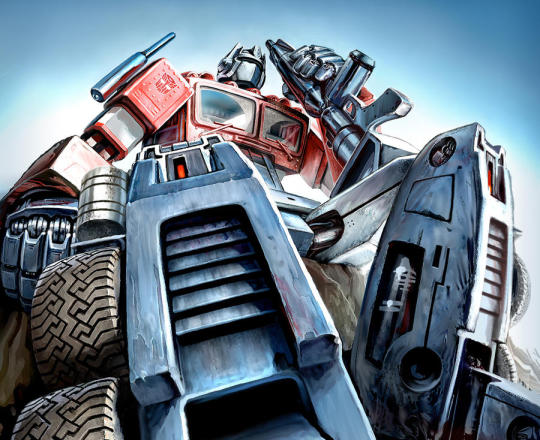
Fan Art: Ol' Optimus Prime by PatrickThornton
Accompanying Podcasts: ● Return to Cybertron - episode 01
#marvel#marvel comics#my marvel read#transformers#comics#comic books#fan art#podcast recommendation#podcast - return to cybertron#fanart
0 notes
Text
George Santos Imposter Syndrome
LOS ANGELES (OnlineColumnist.com), Jan. 2, 2023.--Newly elected Rep. 34-year-old, Brazilian-born George Santos (R-N.Y.) shocked voters and the press when they found out he misrepresented large parts of his resume en route to one on the most unlikely feats seen recently in U.S. politics. Republicans were desperate to run anyone in New York’s Third Congressional district in Queens, finding an energetic 34-year-old gay man, the perfect woke candidate to run against Robert Zimmerman, a longstanding Democratic National Committee [DNC] member and political commentator on CNN, MSNBC and Fox News. When Rep. Tom Suozzi (D-N.Y.) decided to run for governor, it opened up his seat, something the Republican National Committee [RNC] jumped on. Who could be a more woke candidate than flamboyant George Santos? Few could figure out that Santos was a fraud, a person suffering from a clinical condition called “the imposter syndrome.”
Former President Donald Trump, 76, epitomized through his long real estate and reality TV career that everyone has to “fake it, till you make,” part of the America’s history of highly competitive entrepreneurial capitalistic society. No one in recent American history personified the entrepreneurial class more than Trump, who built his brand over 50 years based on his embellished best-selling autobiography co-written with Tony Schawartz the Nov. 1, 1987 “Trump: The Art of the Deal.” Unlike Santos, Trump really did graduate from Penn’s Wharton School, working closely with his millionaire father Fred Trump in Queens before breaking into Manhattan real estate, building skyscrapers. Parallels to Santos break down because Trump was actually the real deal when it came to building a real estate empire. Santos, from descriptions of him from different sources, was a fraud.
Trump’s rise from real estate tycoon to TV reality star to President of the United State was a remarkable path to the White House. Trump ran in 2016, against all odds, taking on Democrat political dynasty career politician, 75-year-old Hillary Rodham Clinton. Trump’s Electoral College victory Nov. 3, 2016 was a remarkable feat considering the institutional advantage Hillary enjoyed in a long political career backed by nearly every newspaper and broadcast outlet in the country. Trump pulled off a nearly impossible feat because the public, Democrats, Republicans and independents, all admire American success stories. So on that basis, on a more modest scale, lowly George Santos, without a normal high school degree, pulled off another stunning feat, winning a seat in U.S. Congress, defeating Democrat Robert Zimmerman Nov. 8, 2022 with the help of the RNC.
Santos grew up after immigrating in a basement apartment in Queens with his mother, Fatima Devolder, who died in 2016. Santos described her as an American Dream who worked her way up from the bottom to become “the first female executive at a major financial institution,” the kind of embellishment typical of individuals suffering from an imposter syndrome. Santos said his mother was in the World Trade Tower on Sept. 11, 2001, dying a few years later. More accurate reports had Santos mother working as a domestic worker, speaking speaking in her native tongue, Portuguese. No mention was made in Santo’s biography his father, most likely out of wedlock. Court records shows Santos, age 20, and his mother living in a slum area outside Rio de Janiero in 2008, contradicting his biography saying he attended Horace Mann School in the Bronx in 2006, before dropping out.
All the discrepancies in Santos background, including his openly gay relationship with Pedro Vilarva, 18, when he was 26. Vilarva said they dated for about two months before he broke it off because Santos didn’t pay his bills. “He used to say he would get money from Citigroup, he was an investor,” Vilarva said. “One day it’s one thing, one it’s another thing. He never actually went to work,” knowing that Santos said he worked on Wall Street. Whatever embellishments in work history, Samtps readily told Queens voters in his campaign that he had Jewish background, when there was no evidence for his claims. All in all, when Santos gets sworn into Congress Jan. 3, House leadership will have to evaluate what to do. Santos rival, Zimmerman, said he wants Santos to resign do to all the obvious lies. Incoming House Minority Leader Rep. Hakeem Jeffries (D-N.Y) said Santos was “unfit to serve.”
When Santos is worn in tomorrow as a member of Congress, Democrats will no doubt ask for an ethics investigation over his misstatememts. Rep. Elise Stefanik (R-N.Y.) said she warned her colleagues about Santos, saying that things didn’t add up in his background. With Santos meager background, House leaders will have to decide whether he crossed a line misrepresenting himself to voters. Many politicians misrepresent their backgrounds and experience, including 80-year-old President Joe Biden. So, before House leaders decide what to do with Santos, they need to look at their own embellishments. Santos, due to his sketchy background, made up stories about himself to preserve his self-esteem and dignity. Imposter syndromes are not criminal acts but attempts to compete in a brutal system demanding that every rival has something special to talk about.
About the Author
John M. Curtis writes politically neutral commentary analyzing spin in national and global news. He’s editor of OnlineColumnist.com and author of Dodging The Bullet and Operation Charisma.
0 notes
Photo

Are You A Wantrepenuer or Entrepreneur? Why Veterans Make The Best Entrepreneurs. On This Episode Of Vertical Momentum Resiliency Podcast We Chat With The Modern Day Wizard Of Oz , Legendary Author, Speaker & Entrepreneur Steve D. Sims. TO LISTEN/WATCH ON YOUR Favorite PLATFORMS CLICK HERE https://linktr.ee/VerticalMomentum Or Watch NOW ON YOUTUBE https://youtu.be/LLKtaZrdO3U We chat about Going For Stupid The Art Of Achieving Ridiculous Goals His New Book 📕 💣 Top knowledge Bombs 💣 Why are rich people wealthy and successful? Why Donald J. Trump actually won the Presidency over Hillary Clinton. What is the ten bucks 💵 challenge that can save you thousands if not hundreds of thousands of dollars? Wow this is a master class on how to dominate YOUR market in 2022/2023 To pick up his amazing book click here https://a.co/d/h2WES8U Thank you to our sponsors Vertical Momentum Resiliency Podcast Coffee makers of the BEST HIGH ENERGY COFFEE IN THE WORLD that is hand roasted by Veterans and 100% of my proceeds go to help ProjectDiehard end Veteran homelessness click here to purchase https://www.thirddaycoffeeseguin.com/product-page/vertical-momentum Thank you to TEAM VMNATION 🙏 William Maitre Ginger N David Really? Designs Patrick Burt Kennedy Page Daniel Curry Indy's It Department Podc Ast Promote R Jose Roberto Alaniz Jr. Third Day Coffee Robert N. Kerzee #entrepreneur #business #success #bluefishing #Wantrepreneur #mindsetmatters (at North Arlington, New Jersey) https://www.instagram.com/p/Cj3yv3bLpFc/?igshid=NGJjMDIxMWI=
0 notes
Text







I finally made the comic about Sick Sky stalking Drugfriend and this time, she's getting send to the asylum for 40 years for stalking and attempted murder
@pony-centralWhat do you think, also after you make the comic about Naughty PonyCentral and Sick PonyCentral sharing the donut stash, Can you remake this one as well? if you want
#fnf spongebob parodies#friday night funkin#fnf mod#ponycentral#comics#Hillary's world art 2023#Sick Sky
13 notes
·
View notes
Text
Anlagekommentar September 2020 - Die Fed passt ihre Strategie an und die Aktienmärkte vollziehen die längst fällig gewesene Marktkorrektur
Die Fed hat Ende August das Resultat der Überarbeitung ihrer geldpolitischen Strategie bekanntgegeben. Demnach wird künftig auf eine präventive geldpolitische Straffung bei einem angespannten Arbeitsmarkt verzichtet, solange die Inflation nicht steigt. Zudem wird das 2 Prozent-Inflationsziel als Mittelwert interpretiert, um die langfristigen Inflationserwartungen am Markt im Rahmen des 2 Prozent-Ziels zu verankern. Somit stehen die Änderungen im Einklang mit dem Umfeld der letzten Jahre, in denen trotz einer rekordtiefen Arbeitslosenrate kaum ein Inflationsdruck zu merken war. Zusammengefasst dürfte deshalb die Neuausrichtung der Fed dazu führen, dass die Fed-Zinsen noch für einige Jahre auf den aktuell sehr niedrigen Niveaus verbleiben werden.
Entwicklung der Anlagemärkte Die Börsen haben also im September die längst fällig gewesene Marktkorrektur abgeliefert. Da der September statistisch gesehen zu den schwächsten Börsenmonaten des Jahres zählt, war dies auch so zu erwarten gewesen. Dabei haben vor allem die hoch gehandelten Technologieaktien kräftig korrigiert, während zyklische Werte besser bestehen konnten. So lag der Technologieindex NASDAQ 100 Index zeitweise über 10 Prozent unter seinem zum Monatsanfang markierten Allzeithoch und beendete den September schließlich mit einem Minus von 5,7 Prozent. Aufgrund der hohen Gewichtung von Technologiewerten im US-Aktienindizes S&P 500 Index verlor dieser auch 3,9 Prozent. Die europäischen und asiatischen Pendants konnten sich etwas besser behaupten, so dass der Eurostoxx 50 Index nur um 2,4, der deutsche DAX Index um 1,4 Prozent, der britische FTSE 100 Index um 1,6 Prozent nachgaben und der NIKKEI 225 Index sogar im leichten Plus mit 0,2 Prozent landete. Der weltweite MSCI World (EUR) schloss dementsprechend auch mit einem Minus von 2,4 Prozent.
Zum Monatsende konnten jedoch die fortschreitende Erholung Chinas, die anhaltende Verbesserung der Unternehmens- und Konsumentenstimmung und hervorragende Zahlen vom US-Immobilienmarkt die Abwärtsbewegung aufhalten. An den Rentenmärkten gab es dagegen ein spiegelbildliches Bild, wobei die zehnjährige deutsche Staatsanleihen um 0,13 Prozent deutlich niedriger bei -0,52 Prozent rentierte. Bei den langlaufenden US-Staatsanleihen sank dagegen die Rendite kaum merklich um drei Basispunkte. Die US-Notenbank Federal Reserve System (Fed) änderte zwar wie erwartet ihre Inflationsstrategie, wodurch die Geldhüter nun ein durchschnittliches Inflationsziel von zwei Prozent im Blick haben, was mehr Flexibilität bei kurzfristigen Abweichungen bietet. Die Mehrheit der Fed-Mitglieder geht mittlerweile davon aus, dass es bis Ende 2023 zu keiner Leitzinserhöhung kommt. Allerdings reagierten jedoch die Marktteilnehmer enttäuscht darauf, dass der Präsident Jerome Powell trotz der Warnungen vor einer schwächeren Wirtschaftserholung und der erneuten Aufforderung an die Politik, dass die Wirtschaft fiskalisch unterstützt werden muss, keine Aufstockung der Anleihekäufe anvisierte. Dagegen gab es bei der Europäische Zentralbank (EZB) keine geldpolitischen Änderungen. Allerdings betonte das EZB-Mitglied Philip Lane, dass für die Notenbank der Euro-Wechselkurs durchaus wichtig sei.
Was könnten die US Präsidentschaftswahlen für die Aktienmärkte bringen Es gibt dabei die drei möglichen Grundszenarien lauten:
Donald Trump wird wiedergewählt
Joe Biden gewinnt klar
Donald Trump wird die Wahl anfechten und führt endlose Verfahren vor Gericht
Dann wäre im letzten Fall die aktuelle Sprecherin des Repräsentantenhauses Nancy Pelosi die Interimspräsidentin, bis alle Verfahren abgeschlossen sind. Dies ist in der US Verfassung so vorgegeben, denn sie ist nach dem Präsidenten und dem Vizepräsidenten die nächste Instanz in der Nachfolgereihung für den US-Präsidenten. Wenn es dazu kommen würde, wäre dies ein durchaus interessantes Szenario für die amerikanische Politik. Grundsätzlich muss man feststellen, dass sich Wahlanfechtungen für die Stimmung an den Finanzmärkten nicht günstig auswirken, weil sie naturgemäß eine Menge Unsicherheit mit sich bringen.
Ein Wahlsieg von Donald Trump gilt als günstig für die Börsen. Im Falle eines Wahlsieges von Joe Biden wird beispielsweise nach Ansicht von Goldman Sachs eine kurzfristige negative Marktreaktion zu erwartet. Dennoch werden auch in diesem Fall keine mittelfristigen oder langfristigen negativen Folgen auf die Kursentwicklung an den Finanzmärkten befürchtet. Auch die von Joe Biden oftmals als negativ beurteilte geplante Einkommensteuererhöhung würde ohne dies erst ab einem Jahreseinkommen von USD 400.000 wirken und somit die für den Konsum so bedeutende Mittelschicht nicht betreffen.
Die heiße Phase des Wahlkampfes hat begonnen… Dass Donald Trump eine sehr enthusiastische Fangemeinde besitzt, ist wohl jedem mittlerweile hinlänglich bekannt. So hält er auch weiterhin zahlreiche Wahlkampfveranstaltungen vor Ort ab und lässt sich dabei gebührend feiern. Ob das in der Corona-Pandemie so durchgehalten werden kann, muss abgewartet werden. Joe Biden ist da wesentlich zurückhaltender, was Donald Trump in diesem Punkt durchaus Vorteile bringt. In der weiteren Wahlauseinandersetzung könnte auch das Thema „Fracking“ ein wichtiger Punkt werden. Denn diese umwelttechnisch fragwürdige Art der Rohölgewinnung hat vor allem in den Bundesstaaten Pennsylvania und New Mexico eine große Bedeutung und Joe Biden aktuell noch keine klare Position bezogen hat, ob er Fracking gesetzlich verbieten würde oder nicht. Dies ist deshalb besonders wichtig, weil die Fracking Industrie in der Zwischenzeit für einen erheblichen Teil der Arbeitsplätze in diesen beiden Bundesstaaten sorgt. Dagegen hat Donald Trump in Anbetracht der Unruhen der letzten Monate immer wieder betont, dass er für die öffentliche Sicherheit die beste Wahl wäre. Nunmehr hat er seine Strategie verändert und behauptet nun, dass er der Beste wäre, um die wirtschaftliche Erholungsphase in den USA anzuführen.
In diesem Zusammenhang ist es allerdings eine interessante Tatsache, dass gerade in den wichtigen „Swing States“ Joe Biden mit dem einsammeln von Spenden für den Wahlkampf sehr erfolgreich ist. Donald Trump muss dagegen derzeit mit einem rückläufigen Spendenaufkommen kämpfen. Allerdings kann auch Donald Trump Pluspunkte aufbieten, beispielsweise mit der Tatsache, dass er nunmehr durchsetzen konnte, dass in den USA wieder Football gespielt werden kann. Das ist für den amerikanischen Nationalsport und somit für weite Teile der Bevölkerung eine ganz wichtige Sache. Auch das derzeit sehr aktuelle Thema der Nachbesetzung der durch das Ableben der von Ruth Bader Ginsburg vakant gewordenen Richterstelle im US-Höchstgericht spielt Donald Trump in die Karten. Dies vor allem deshalb, da dem US-Höchstgericht im Falle einer Anfechtung der US-Wahlen eine entscheidende Rolle zukommen wird. Donald Trump will deshalb die Nachbesetzung durch seine Kandidatin Amy Coney Barrett unbedingt noch vor dem Wahlurnengang durchziehen.
Zusammenfassend kann man deshalb feststellen, dass in der Summe der oben geschilderten Faktoren Donald Trump derzeit wohl einen gewissen Vorteil im Präsidentschaftsrennen hat. Dagegen führt in den Meinungsumfragen derzeit Joe Biden, was allerdings bei der letzten Präsidentenwahl bei Hillary Clinton auch so war und Donald Trump dennoch gewonnen hat.
Was ist nun für die Börsen das beste Wahlergebnis? Unabhängig der Person ist das beste Wahlergebnis für die Börsen ein klarer Wahlsieger. Dann können sich die Wertpapiermärkte wieder völlig ihren Themen widmen, nämlich der Entwicklung der Volkswirtschaft und der Unternehmensgewinne. Daher würde eine endlose gerichtliche Auseinandersetzung einer positiven Kursentwicklung für den Rest des Jahres sicherlich abträglich sein, denn traditionell ist das letzte Quartal eines Jahres das stärkste.
Ein Blick auf die aktuellen Anlagestrategien Hauptsächlich die Kurse von Aktien und etwas weniger ausgeprägt jene von Unternehmensanleihen haben sich in den letzten Monaten als Folge von zusehends weniger negativen fundamentalen Entwicklungen und reduzierten Unsicherheiten deutlich erholt. Deshalb haben sich viele Aktienbörsen von den zuvor erlittenen Einbrüchen mittlerweile fast gänzlich erholt. Allerdings bleibt die Corona-Pandemie das weiterhin bestimmende Thema an den Finanzmärkten. Die unlängst gestiegenen Spannungen zwischen den USA und China dürften wohl hauptsächlich den anstehenden US-Wahlen geschuldet sein und die Wirtschaftsentwicklung kaum beeinflussen. Angesichts der Tatsache, dass die Wirtschaft auch mittelfristig aus strukturellen Gründen nur verhalten wachsen wird und die Corona-Pandemie noch nicht überwunden ist, sollte man unverändert einen klaren Fokus auf Qualitätsanlagen legen. Da die Zinssätze und Anleiherenditen in den wichtigsten Volkswirtschaften über einen längeren Zeitraum nahe ihrer Rekordtiefs bleiben dürften, gewinnen Aktien von Unternehmen mit einer soliden Dividendenhistorie weiter an Attraktivität.
Trotz einer möglicherweise hohen Marktvolatilität in den kommenden Monaten, sollte man sich als Anleger zunehmend auf eine weitgehende Normalisierung der wirtschaftlichen Aktivität in den kommenden 12-24 Monaten einstellen. Zu berücksichtigen gilt auch, dass sich die relevanten Stellen, wie Regierungen, Gesundheitssysteme, Einzelpersonen und Unternehmen seit Monaten viel dazu gelernt haben, mit der Situation umzugehen. Daher sollte eine Anlagestrategie defensiv gestaltet sein. Gleichzeitig ergeben sich aber besonders bei Aktien auch Chancen für mittelfristig und langfristig agierende Anleger. In der aktuellen Phase sind Unternehmen zu bevorzugen, die sich bisher in wirtschaftlich schwierigen Zeiten bewährt haben, eine solide Bilanz aufweisen.
Weiterhin sorgen dennoch Dividendenwerte für gute Erträge und der regionale Fokus im Aktienbereich bleibt weiter auf Europa und den USA gerichtet. Als interessantes langfristiges Thema zur Depotbeimischung kann der Fokus auf eine „Alternde Gesellschaft“ gelegt werden und über unterschiedliche Anlagemöglichkeiten abgebildet werden. Auch globale Immobilienaktienfonds können zur Depotdiversifikation beitragen, denn stabile Dividendenzahlungen durch regelmäßige Mieterträge und die Partizipation an aussichtsreichen Langfristtrends zeichnen diesen Anlagebereich aus. Da die Renditen für Staatsanleihen in Europas Kernländern bei kurzen bis mittelfristigen Laufzeiten oft negativ sind, bleibt das Umfeld für Anleihen-Investoren weiter eine Herausforderung. Auch nach dem die Kreditaufschläge in der letzten Zeit zurückgegangen sind, bleiben die Unternehmensanleihen weiterhin die bessere Ertragsperspektive als die Staatsanleihen. In diesem Umfeld sollten Unternehmensanleihen aus dem gesamten Euroraum weiter den Vorzug bekommen.
wichtiger Hinweis: Dieser Bericht dient ausschließlich zu Informationszwecken und die Angaben wurden mit Sorgfalt zusammengestellt. Für die Richtigkeit kann jedoch keine Gewähr übernommen werden. Allein verbindliche Grundlage für den Erwerb von Investmentfondsanteilen sind die jeweiligen Verkaufsprospekte und die jährlichen Rechenschaftsberichte. Diese sind Grundlage für die steuerliche Behandlung der Fondserträge. Die auf Fondsebene anfallenden Kosten (z.B. die Verwaltungsvergütung) wurden berücksichtigt. Die auf Kundenebene anfallenden Kosten (Ausgabeaufschlag und Depotkosten) sind ggfs. nicht berücksichtigt. Bei Fremdwährungen kann die Rendite infolge von Währungsschwankungen steigen oder fallen.
Die Informationen sind unverbindlich und stellen weder eine Anlageempfehlung oder sonstige Beratung, ein Angebot oder eine Aufforderung zum Kauf oder Verkauf von Wertpapieren oder Finanzinstrumenten dar. Sie ersetzen kein persönliches Beratungsgespräch. Eine Anlageentscheidung bedarf der individuellen Abstimmung auf die persönlichen Verhältnisse und Bedürfnisse des Anlegers. Die dargestellten Informationen, Analysen und Prognosen basieren auf dem Wissensstand und der Markteinschätzung zum Zeitpunkt der Erstellung. Für die Richtigkeit, Vollständigkeit und Aktualität der Daten sowie das Eintreten von Prognosen wird keine Haftung übernommen. Die frühere Wertentwicklung ist kein verlässlicher Indikator für die künftige Wertentwicklung.
Erläuterungen zu den Berechnungsgrundlagen: Die Entwicklungen bzw. Endbeträge und Volatilitäten werden auf EUR-Basis berechnet. Grundlage für die Berechnung der Volatilität: Monatliche Returns, logarithmiert, annualisiert. Eventuelle Ausschüttungen bei Investmentfonds werden wieder angelegt. Die Wertentwicklung basiert auf 100 Prozent des Kapitaleinsatzes, die Wertentwicklungen p.a. und Volatilitäten werden aus dem gesamten der Auswertung zugrundeliegenden Zeitraum (wie angegeben) bestimmt.
Externe Quellen:
Kategorie-Durchschnitte: monatliche Berechnung durch EDISOFT GmbH über das Fondsuniversum der FVBS-Datenbank
Zinsen (Festgeld, Sparbuch): monatliche Durchschnittswerte der Dt. Bundesbank aus Meldungen deutscher Kreditinstitute
Inflation: monatliche Zahlen des Statistischen Bundesamts
Goldpreis: offizieller Feinunzen-Preis/London
Anlagekommentar als eBook herunterladen
Leseempfehlungen
Lesen Sie doch auch diese Artikel rund um das Thema Finanzen, wofür sich auch andere Leser interessierten:
Wie ist man im Home-Office richtig versichert Sparpläne - Der Trick mit dem Durchschnittskosteneffekt Das Finanzamt an Handwerker-Kosten beteiligen
Bildnachweis
0 notes
Text
Hyperallergic: Life After Art: William Powhida’s Futures Market
Installation view of William Powhida’s “After the Contemporary” at the Aldrich Museum of Contemporary Art (all images via williampowhida.com)
RIDGEFIELD, Connecticut — I can tell you the moment when, in mid-March 2016, Donald Trump’s presidential campaign stopped being funny, and I can tell you the moment when, after spending more than two hours with the show, William Powhida: After the Contemporary stopped being funny.
It was when I reached the placard at the warren-like installation’s dead end, and read the following passage:
The permanent relocation of both Art Basel’s Miami Beach edition and the general population of Miami Beach following the devastating flooding of Hurricane Hillary in 2023 served to wind down the Contemporary period. Art Basel ushered in the Alt-Contemporary with the announcement of its ambitious plans for a private, Ultra-only fair in Thieland, a micronation established by legendary ArtsTech guru Peter Thiel in 2025.
I should hit pause for a moment and explain that Powhida’s exhibition, which takes up half of the Aldrich Contemporary Art Museum’s second floor, is a meta-besotted extravaganza of image and text, mostly text, purporting to take place in the year 2050.
Installation view of William Powhida’s “After the Contemporary” at the Aldrich Museum of Contemporary Art
Filled with futuristic arcana and art world in-jokes (including one aimed at the editor-in-chief of this publication), it takes the form of a survey tracing a quarter-century of contemporary art history, using Powhida’s benighted career arc and the rise of Grevsky™ — the corporate art-generating entity he co-founded with the collector Seth Stolbun in 2016 — as its touchstones.
To unpack the above-quoted text: the “Contemporary period” is a time more or less synonymous with Modernism, in which artists maintained their ”historic position as avant-garde, iconoclastic figures who rejected the status quo and the dominant values of society.”
These values, however, had been “slowly compromised by the increasing professionalization of the visual arts after World War II,” which tempted artists with “the possibility of joining the middle class through sales and teaching.” (All quotations are from the exhibition’s placards.)
By 2050, however, the Contemporary has been replaced by the “Alt-Contemporary” (hence the exhibition-within-the-exhibition’s title, After the Contemporary: Contemporary Art 2000-2025) — an era forecast by The Forever Now: Contemporary Painting in an Atemporal World, a show that opened at the Museum of Modern Art in December 2014.
The Forever Now was a turning point, codifying a cultural paradigm in which “artists were no longer bound by time or innovation and could borrow from any period of art to produce paintings” — a “winnowing of style” from the personal and political to the corporate and homogenous, which was viewed not as “an aberration or error of judgment” but “a triumph of the erudite sensibility of the Ultra collector, whose tastes and desire for apolitical content had already begun to directly influence the production of culture.”
Eventually, the class of super-rich patrons (known as Hereditary Ultra High Net Worth Collectors, or Ultras — which is also a term used by the speculative fiction writer Alastair Reynolds to designate “a post-human race of technologically advanced immortals”) began to demand “the luxury of art” while rejecting “the burden of supporting artists.”
This is the niche that Grevsky™, the corporation formed by Powhida and Stolbun, sought to fill by ordering works from anonymous artist subcontractors and marketing them solely under the Grevsky brand, which ultimately absorbed Powhida’s creative rights as well, triggering a lawsuit, near-bankruptcy, divorce, and exile in a borrowed shack in Costa Rica, where he spends his golden years painting pathetic pictures of clowns and donkeys.
Installation view of William Powhida’s “After the Contemporary” at the Aldrich Museum of Contemporary Art
This synopsis barely skims the surface of a multilayered, impudent, lacerating exhibition that pricks pretense and self-delusion on every level, from mega-rich collectors fancying themselves pillars of civilization to politically committed artists rationalizing their aspirations to the high-end gallery system. (Subplots include the oligarchical “Great Restoration of a natural social order that did not include a middle class”; the suppression of social justice movements; efforts at worldwide depopulation; extreme climate events; the defunding of the NEA; the 2024 merger of Gagosian and Zwirner; and the development of derivative algorithms to perpetuate the careers of deceased art stars.)
Powhida has been alternately called a conceptual artist and a political artist, and here he demonstrates that he is both and, it could be argued, neither. This is an exceedingly text-heavy show, to the point of self-parody, with nine eight-by-four-foot panels of sheetrock covered with narration and, in one instance, cultural and economic timelines. There are also nine pages of a Grevsky™ artist’s contract on display, and various crumpled pages apparently cut from future issues of Artforum (aka “Twenty Five Years of Impenetrable Discourse,” the title of a 2017 sculpture featuring magazines stacked floor-to-ceiling), including a wholly credible obituary of Jeff Koons (who died in 2025, according to the information on hand, in a self-driving Uber accident, an event that spurred the development of algorithmic editions for posthumously generated artworks).
And yet, the texts on the sheetrock are hand-stenciled in pencil — with full justification, no less — which defines the exhibition as a work of immense physical labor. And up and down the edges of the panels are dozens of snarky, subversive, and hilarious marginal notes, written in red and all caps, that systematically undercut the more straightforward narration of the pencil text.
And so, what, formally, is going on here? Powhida possesses some of the best drawing chops of anyone working today, yet he seems to be deliberately suppressing the visual. (The only place where his skills are fully manifested is in the small “retrospective” in the exhibition’s final room, where the introductory wall text confides, “The artist’s work remains significantly undervalued in the secondary market and would make an excellent addition to any collection.”)
Installation view of William Powhida’s “After the Contemporary” at the Aldrich Museum of Contemporary Art
The exhibition’s dearth of imagery is compounded and contradicted by the intense, protracted labor that went into the stenciling, which, paradoxically, also delivers a potent materiality and an old-fashioned sense of touch. These placards and charts, with their bravura precision, red highlights, and subtle, silvery textures are a hundred times more alive than the blindingly boring generic works on display in the faux Grevsky™ art fair booth in the middle of the exhibition.
The booth is key to the exhibition’s refusal to distinguish between parody and reality — its collection of paintings, ceramics, and fabrics — dominated by a giant color photograph of the Trump Taj Mahal and presided over by a video simulacra of a bored gallerista — are indistinguishable from bona fide Art Basel Miami Beach tchotchkes. If this is life after art — in which the work of “iconoclastic figures who rejected the status quo and the dominant values of society” has given way to “a triumph of the […] tastes and desire for apolitical content” — then isn’t the iconoclasm of the relentless text panels the only legitimate response?
But the denial of art represented by the text panels is undermined, to my eye, by the thrum of the human activity that created them. Is this then a hint of resurrection stirring beneath the values of a collector class “who derived their wealth and status almost entirely from returns on pure and perfect capital accumulation,” as the exhibition’s introductory text tells us? Or is it the illusion of an optimist?
The maddening thing about Powhida is how closely he holds his cards to his chest. He nonchalantly presents his constructed persona, a narcissistic fraud named William Powhida (here played in a video interview by Amos Satterlee) as the author of his work, which routinely skewers the art establishment’s glitterati with assertions bordering on the libelous. His compulsion for playing fast and loose with the facts, however, always seems to be operating at the service of some higher, darker truth.
And he does so especially in After the Contemporary, which effortlessly harnesses his obsession with art world inside baseball to a righteous anger fired by political hypocrisy, exploitation, and opportunism. Here it is obvious that art, as an investment tool for “hereditary heirs […] primarily from established art-collecting families with their own private museums,” isn’t simply symbolic of the economy’s subjugation by the financial elite, but rather, in itself, an irrefutable engine of that subjugation.
Still, paradoxes abound, and the same art that is compromised, denied, and vilified throughout the exhibition retains the power of revelation. As I read the lines quoted above citing “Thieland, a micronation established by legendary ArtsTech guru Peter Thiel,” I suddenly recalled watching Donald Trump on television last March, whipping up his followers with his cock-of-the-walk strut and Mussolini chin-thrusts, sucking up their vitriol and spewing it back at them like some kind of fire-breathing ogre. Something, at that moment, seemed irretrievably broken.
A little more than a year later, the idea of a neo-feudal state dominated by an impregnable economic elite whose personal wealth exceeds that of the French Ancien Régime, or a micronation governed by a data-mining billionaire, suddenly seemed as implausible as the presidency of Donald J. Trump.
William Powhida: After the Contemporary continues at the Aldrich Contemporary Art Museum (258 Main Street, Ridgefield, Connecticut) through September 4.
The post Life After Art: William Powhida’s Futures Market appeared first on Hyperallergic.
from Hyperallergic http://ift.tt/2q1nMgC via IFTTT
0 notes
Text
Princess Hillaryella's Ice cream stash

People are free to take some but they have to ask permission first from the princess
@pony-central what do you think?
8 notes
·
View notes
Text
When Oreo-Heart is Hungry

Should my oc eat chicken, lollipops or donuts?
You guys pick
@pony-central
@funkinboys
@ethanvanii
3 notes
·
View notes
Text
Transformers (UK, vol. 1) #1: The Transformers
Read Date: April 10, 2023 Cover Date: September 1984 ● Writer: Bill Mantlo ◦ Ralph Macchio ● Penciler: Frank Springer ● Inker: Kim DeMulder ● Colorist: Nelson Yomtov ● Letterer: Michael Higgins ◦ Rick Parker ● Editor: Bob Budiansky ●

**HERE BE SPOILERS: Skip ahead to the fan art/podcast to avoid spoilers
Reactions As I Read: ● “naturally occuring gears, levers and pulleys” - that still gets me ● and there’s mention of the war being so powerful that Cybertron was shaken loose from its orbit. I'd forgotten about that

● that deer on page 16 looks… really wonky ● 👏👏👏👏
Synopsis: The planet Cybertron, home of sentient robots known as the Transformers, has been at war for millions of years, putting the peace faring Autobots at war against the evil war hungry Decepticons, led by the evil Megatron. The devastation wrought by the war would send planet Cybertron out of it's orbit spinning throughout the cosmos on an indirect course, and into the path of an asteroid belt that threatens to destroy their home world unless something is done. Autobot commander Optimus Prime is selected by the Autobot elders to lead a team to destroy the meteors before it's too late.
Optimus Prime selects a crew that consists of the following Autobots: Bumblebee, Cliffjumper, Brawn, Huffer, Gears, Jazz, Prowl, Ironhide, Ratchet, Sideswipe, Sunstreaker, Trailbreaker, Wheeljack, Mirage, and Hound to journey out in their ship, the Ark, to destroy the meteors. Learning of this, Megatron gathers a team of his own Decepticon warriors to attack and destroy the Autobots. With him, he takes Soundwave, Starscream, Thundercracker, Skywarp, Laserbeak, Buzzsaw, Rumble, Frenzy and Ravage to attack.
With the battle leaning toward Decepticon victory Optimus Prime, forseeing this possibility sets the Ark on a suicidal collision course with the nearest planet, which happens to be Earth. They crash into an active volcano, destroying them all. Some four billion years later at the site of the crash at what is now called Mount St. Hillary in Oregon the Ark's computers spring to life sending out a probe to scan what it thinks are the planet's sentient machinery. The ships repair systems repair all the Transformers aboard indiscriminately, repairing the Decepticons first and giving them the ability to transform into Earth machines. They manage to escape before the newly revived Autobots can stop them.
Scanning their computers to learn about the world they have crashed on, Optimus Prime decides to that the best course of action is to send out some Autobots to do reconnaissance before they do whatever needs to be done to protect this world from the Decepticons they unwittingly unleashed on this world.
Elsewhere in the state of Oregon, Buster Witwicky, the son of mechanic Sparkplug Witwicky arrives home late from school and gets in trouble with his father who is frustrated with his son for not having an interest in mechanics like he does. With the days work in his garage just about done he allows his son Buster to take the family car out to take his friend "O" and his girlfriend Jessie out to the theater.
Meanwhile, the Autobots Bumblebee, Cliffjumper, Brawn, Prowl, and Hound are on the road getting a lay of the land in their area. They happen upon a drive-in movie theater and thinking that the cars parked there are sentient beings find it odd that they are focused on a large screen. On their journey, they are spied on by Laserbeak who reports back to Megatron. The Decepticon leader decides to send a Decepticon attack force to ambush the revived Autobots.
The Autobots arrive at the theater, and Bumblebee in an attempt to "greet" an Earth car bumps into it. This car happens to be the one that Buster and his friends are in. Buster gets out of the car to yell at the person who bumped him and is shocked to find that there is no driver inside the car. Suddenly, Soundwave, Ravage, Laserbeak, Starscream, Thundercracker, and Skywarp attack the theater prompting the Autobots to transform into robot mode and fight back.
As the humans flee the drive in, the Autobots fight back sending the Decepticons in retreat, but not before one of their blasts can strike Bumblebee. The other Autobots realizing that the sentient life forms on this planet are organic, not mechanical transform into vehicle mode and make their escape before the Decepticons can counter attack. In the chaos, Buster notices that Bumblebee is leaking a fluid that is not oil and decides to take the car back to his garage in an attempt to repair it. He is surprised to find that there is no ignition on the car and is even more surprised when it starts up on its own.
Working hard in a futile effort to try and fix the car, the racket that Buster makes wakes up his father. Sparkplug is delighted to see his son trying to fix up a car on his own, not trying to listen to Buster's explanation about it. However Sparkplug is shocked when Buster tells him that the car is alive, and it weakly asks them for their help.
(https://marvel.fandom.com/wiki/Transformers_(UK)_Vol_1_1)

Fan Art: Bumblebee by zhuyukun
Accompanying Podcasts: ● Return to Cybertron - episode 01
#marvel#marvel comics#my marvel read#transformers#comics#comic books#fan art#podcast recommendation#podcast - return to cybertron#fanart
0 notes